An Overview of Healthcare, Population, and Issues in Saudi Arabia
VerifiedAdded on 2023/01/16
|13
|3106
|74
Report
AI Summary
This report provides a comprehensive overview of the healthcare system in Saudi Arabia, examining its structure, funding, and key challenges. It begins with an executive summary highlighting the government's efforts to improve healthcare standards and the importance of affordable healthcare for the population. The report then delves into the population and demography of Saudi Arabia, including population size, growth rates, literacy rates, and urbanization trends. It also provides statistical data on birth rates, death rates, fertility rates, and life expectancy, differentiating between urban and rural areas. Furthermore, the report identifies priority needs and significant issues within the healthcare sector, such as the cost of private healthcare, the state of government hospitals, sanitation problems, and the patient-to-bed ratio. It also addresses specific diseases like malaria and filaria, and the impact of pollution. The report concludes by providing a detailed analysis of the current healthcare situation in Saudi Arabia, offering valuable insights into the challenges and opportunities facing the nation's healthcare system.
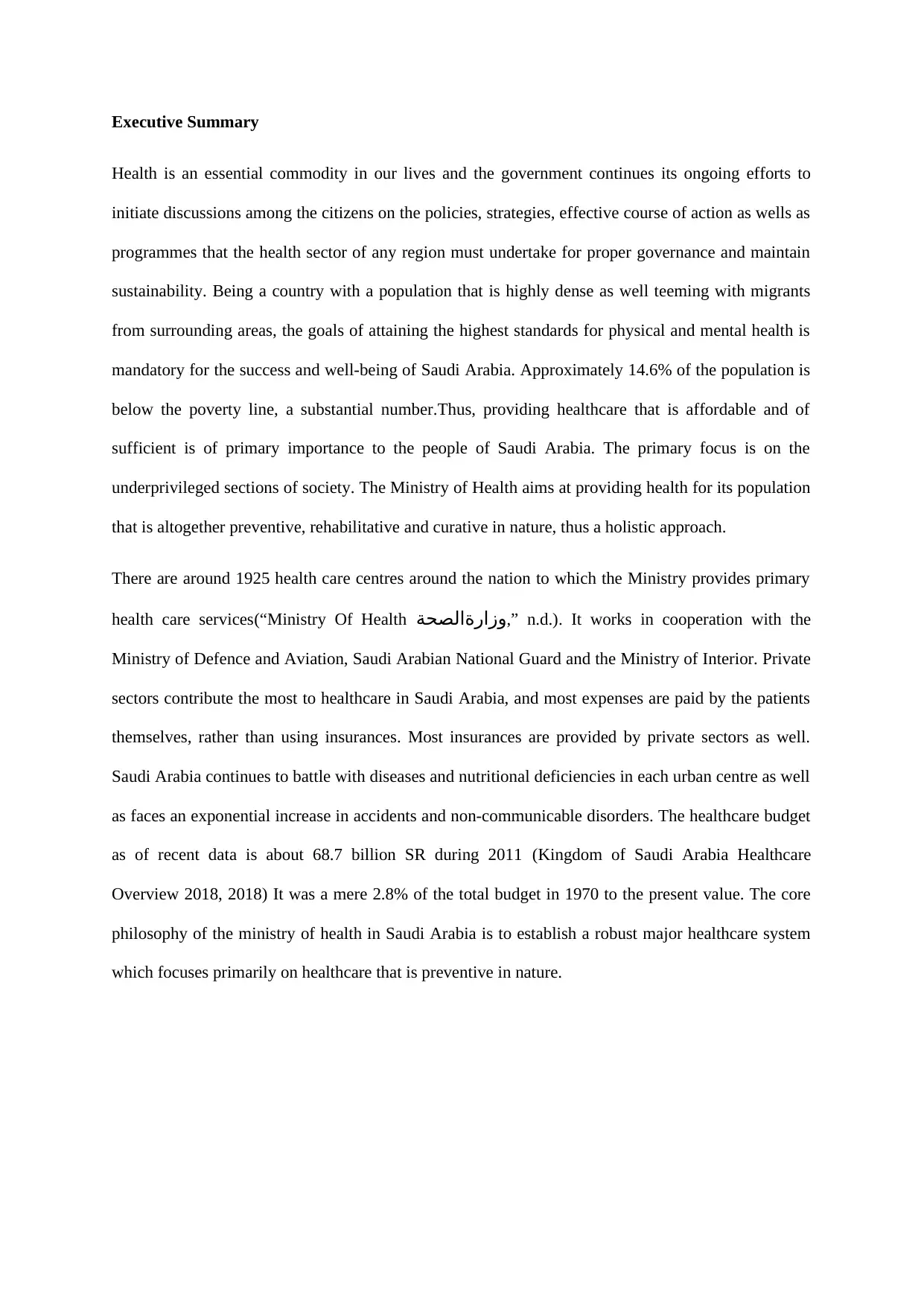
Executive Summary
Health is an essential commodity in our lives and the government continues its ongoing efforts to
initiate discussions among the citizens on the policies, strategies, effective course of action as wells as
programmes that the health sector of any region must undertake for proper governance and maintain
sustainability. Being a country with a population that is highly dense as well teeming with migrants
from surrounding areas, the goals of attaining the highest standards for physical and mental health is
mandatory for the success and well-being of Saudi Arabia. Approximately 14.6% of the population is
below the poverty line, a substantial number.Thus, providing healthcare that is affordable and of
sufficient is of primary importance to the people of Saudi Arabia. The primary focus is on the
underprivileged sections of society. The Ministry of Health aims at providing health for its population
that is altogether preventive, rehabilitative and curative in nature, thus a holistic approach.
There are around 1925 health care centres around the nation to which the Ministry provides primary
health care services(“Ministry Of Health وزارةالصحة,” n.d.). It works in cooperation with the
Ministry of Defence and Aviation, Saudi Arabian National Guard and the Ministry of Interior. Private
sectors contribute the most to healthcare in Saudi Arabia, and most expenses are paid by the patients
themselves, rather than using insurances. Most insurances are provided by private sectors as well.
Saudi Arabia continues to battle with diseases and nutritional deficiencies in each urban centre as well
as faces an exponential increase in accidents and non-communicable disorders. The healthcare budget
as of recent data is about 68.7 billion SR during 2011 (Kingdom of Saudi Arabia Healthcare
Overview 2018, 2018) It was a mere 2.8% of the total budget in 1970 to the present value. The core
philosophy of the ministry of health in Saudi Arabia is to establish a robust major healthcare system
which focuses primarily on healthcare that is preventive in nature.
Health is an essential commodity in our lives and the government continues its ongoing efforts to
initiate discussions among the citizens on the policies, strategies, effective course of action as wells as
programmes that the health sector of any region must undertake for proper governance and maintain
sustainability. Being a country with a population that is highly dense as well teeming with migrants
from surrounding areas, the goals of attaining the highest standards for physical and mental health is
mandatory for the success and well-being of Saudi Arabia. Approximately 14.6% of the population is
below the poverty line, a substantial number.Thus, providing healthcare that is affordable and of
sufficient is of primary importance to the people of Saudi Arabia. The primary focus is on the
underprivileged sections of society. The Ministry of Health aims at providing health for its population
that is altogether preventive, rehabilitative and curative in nature, thus a holistic approach.
There are around 1925 health care centres around the nation to which the Ministry provides primary
health care services(“Ministry Of Health وزارةالصحة,” n.d.). It works in cooperation with the
Ministry of Defence and Aviation, Saudi Arabian National Guard and the Ministry of Interior. Private
sectors contribute the most to healthcare in Saudi Arabia, and most expenses are paid by the patients
themselves, rather than using insurances. Most insurances are provided by private sectors as well.
Saudi Arabia continues to battle with diseases and nutritional deficiencies in each urban centre as well
as faces an exponential increase in accidents and non-communicable disorders. The healthcare budget
as of recent data is about 68.7 billion SR during 2011 (Kingdom of Saudi Arabia Healthcare
Overview 2018, 2018) It was a mere 2.8% of the total budget in 1970 to the present value. The core
philosophy of the ministry of health in Saudi Arabia is to establish a robust major healthcare system
which focuses primarily on healthcare that is preventive in nature.
Paraphrase This Document
Need a fresh take? Get an instant paraphrase of this document with our AI Paraphraser
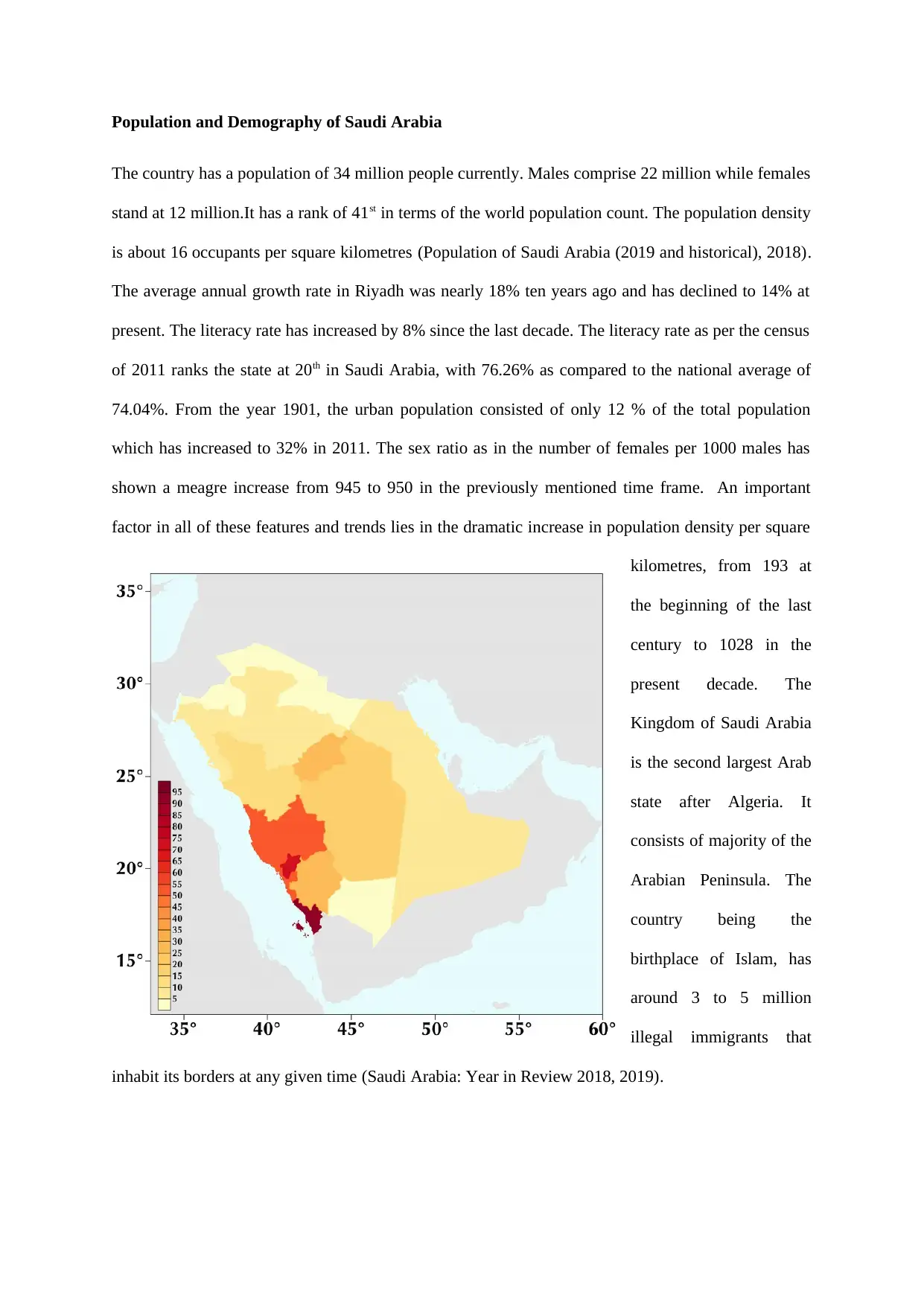
Population and Demography of Saudi Arabia
The country has a population of 34 million people currently. Males comprise 22 million while females
stand at 12 million.It has a rank of 41st in terms of the world population count. The population density
is about 16 occupants per square kilometres (Population of Saudi Arabia (2019 and historical), 2018).
The average annual growth rate in Riyadh was nearly 18% ten years ago and has declined to 14% at
present. The literacy rate has increased by 8% since the last decade. The literacy rate as per the census
of 2011 ranks the state at 20th in Saudi Arabia, with 76.26% as compared to the national average of
74.04%. From the year 1901, the urban population consisted of only 12 % of the total population
which has increased to 32% in 2011. The sex ratio as in the number of females per 1000 males has
shown a meagre increase from 945 to 950 in the previously mentioned time frame. An important
factor in all of these features and trends lies in the dramatic increase in population density per square
kilometres, from 193 at
the beginning of the last
century to 1028 in the
present decade. The
Kingdom of Saudi Arabia
is the second largest Arab
state after Algeria. It
consists of majority of the
Arabian Peninsula. The
country being the
birthplace of Islam, has
around 3 to 5 million
illegal immigrants that
inhabit its borders at any given time (Saudi Arabia: Year in Review 2018, 2019).
The country has a population of 34 million people currently. Males comprise 22 million while females
stand at 12 million.It has a rank of 41st in terms of the world population count. The population density
is about 16 occupants per square kilometres (Population of Saudi Arabia (2019 and historical), 2018).
The average annual growth rate in Riyadh was nearly 18% ten years ago and has declined to 14% at
present. The literacy rate has increased by 8% since the last decade. The literacy rate as per the census
of 2011 ranks the state at 20th in Saudi Arabia, with 76.26% as compared to the national average of
74.04%. From the year 1901, the urban population consisted of only 12 % of the total population
which has increased to 32% in 2011. The sex ratio as in the number of females per 1000 males has
shown a meagre increase from 945 to 950 in the previously mentioned time frame. An important
factor in all of these features and trends lies in the dramatic increase in population density per square
kilometres, from 193 at
the beginning of the last
century to 1028 in the
present decade. The
Kingdom of Saudi Arabia
is the second largest Arab
state after Algeria. It
consists of majority of the
Arabian Peninsula. The
country being the
birthplace of Islam, has
around 3 to 5 million
illegal immigrants that
inhabit its borders at any given time (Saudi Arabia: Year in Review 2018, 2019).
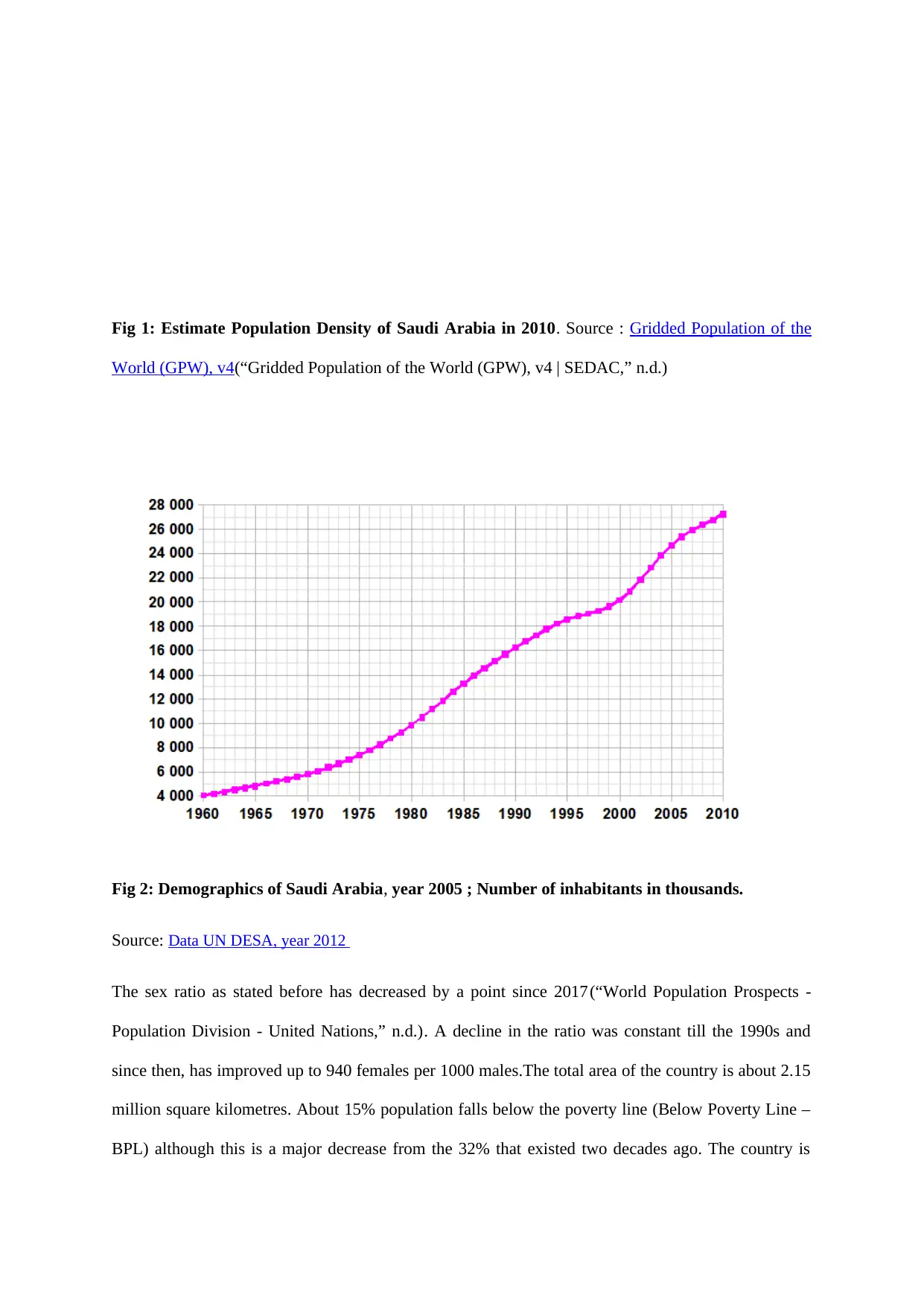
Fig 1: Estimate Population Density of Saudi Arabia in 2010. Source : Gridded Population of the
World (GPW), v4(“Gridded Population of the World (GPW), v4 | SEDAC,” n.d.)
Fig 2: Demographics of Saudi Arabia, year 2005 ; Number of inhabitants in thousands.
Source: Data UN DESA, year 2012
The sex ratio as stated before has decreased by a point since 2017(“World Population Prospects -
Population Division - United Nations,” n.d.). A decline in the ratio was constant till the 1990s and
since then, has improved up to 940 females per 1000 males.The total area of the country is about 2.15
million square kilometres. About 15% population falls below the poverty line (Below Poverty Line –
BPL) although this is a major decrease from the 32% that existed two decades ago. The country is
World (GPW), v4(“Gridded Population of the World (GPW), v4 | SEDAC,” n.d.)
Fig 2: Demographics of Saudi Arabia, year 2005 ; Number of inhabitants in thousands.
Source: Data UN DESA, year 2012
The sex ratio as stated before has decreased by a point since 2017(“World Population Prospects -
Population Division - United Nations,” n.d.). A decline in the ratio was constant till the 1990s and
since then, has improved up to 940 females per 1000 males.The total area of the country is about 2.15
million square kilometres. About 15% population falls below the poverty line (Below Poverty Line –
BPL) although this is a major decrease from the 32% that existed two decades ago. The country is
⊘ This is a preview!⊘
Do you want full access?
Subscribe today to unlock all pages.

Trusted by 1+ million students worldwide
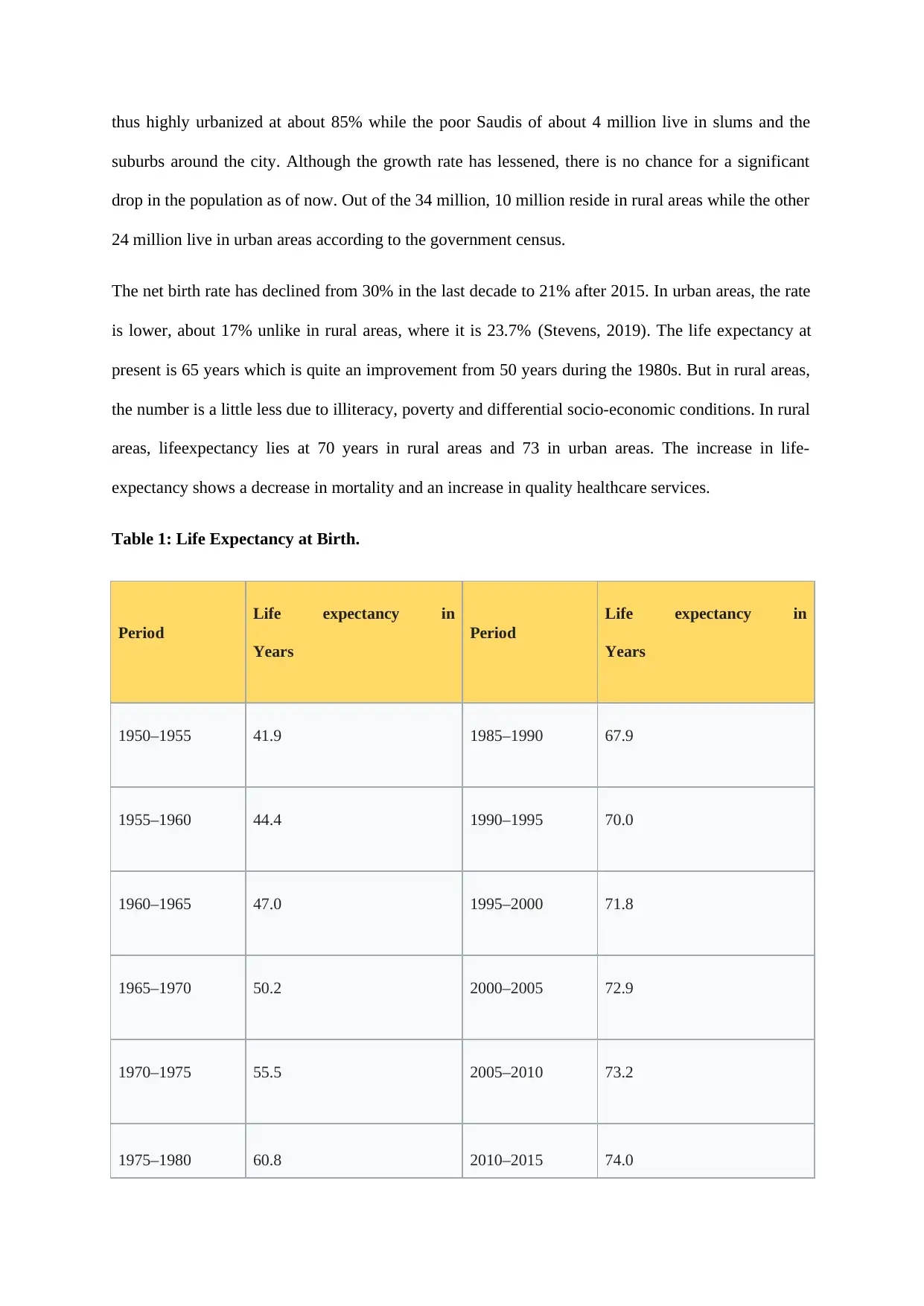
thus highly urbanized at about 85% while the poor Saudis of about 4 million live in slums and the
suburbs around the city. Although the growth rate has lessened, there is no chance for a significant
drop in the population as of now. Out of the 34 million, 10 million reside in rural areas while the other
24 million live in urban areas according to the government census.
The net birth rate has declined from 30% in the last decade to 21% after 2015. In urban areas, the rate
is lower, about 17% unlike in rural areas, where it is 23.7% (Stevens, 2019). The life expectancy at
present is 65 years which is quite an improvement from 50 years during the 1980s. But in rural areas,
the number is a little less due to illiteracy, poverty and differential socio-economic conditions. In rural
areas, lifeexpectancy lies at 70 years in rural areas and 73 in urban areas. The increase in life-
expectancy shows a decrease in mortality and an increase in quality healthcare services.
Table 1: Life Expectancy at Birth.
Period
Life expectancy in
Years
Period
Life expectancy in
Years
1950–1955 41.9 1985–1990 67.9
1955–1960 44.4 1990–1995 70.0
1960–1965 47.0 1995–2000 71.8
1965–1970 50.2 2000–2005 72.9
1970–1975 55.5 2005–2010 73.2
1975–1980 60.8 2010–2015 74.0
suburbs around the city. Although the growth rate has lessened, there is no chance for a significant
drop in the population as of now. Out of the 34 million, 10 million reside in rural areas while the other
24 million live in urban areas according to the government census.
The net birth rate has declined from 30% in the last decade to 21% after 2015. In urban areas, the rate
is lower, about 17% unlike in rural areas, where it is 23.7% (Stevens, 2019). The life expectancy at
present is 65 years which is quite an improvement from 50 years during the 1980s. But in rural areas,
the number is a little less due to illiteracy, poverty and differential socio-economic conditions. In rural
areas, lifeexpectancy lies at 70 years in rural areas and 73 in urban areas. The increase in life-
expectancy shows a decrease in mortality and an increase in quality healthcare services.
Table 1: Life Expectancy at Birth.
Period
Life expectancy in
Years
Period
Life expectancy in
Years
1950–1955 41.9 1985–1990 67.9
1955–1960 44.4 1990–1995 70.0
1960–1965 47.0 1995–2000 71.8
1965–1970 50.2 2000–2005 72.9
1970–1975 55.5 2005–2010 73.2
1975–1980 60.8 2010–2015 74.0
Paraphrase This Document
Need a fresh take? Get an instant paraphrase of this document with our AI Paraphraser
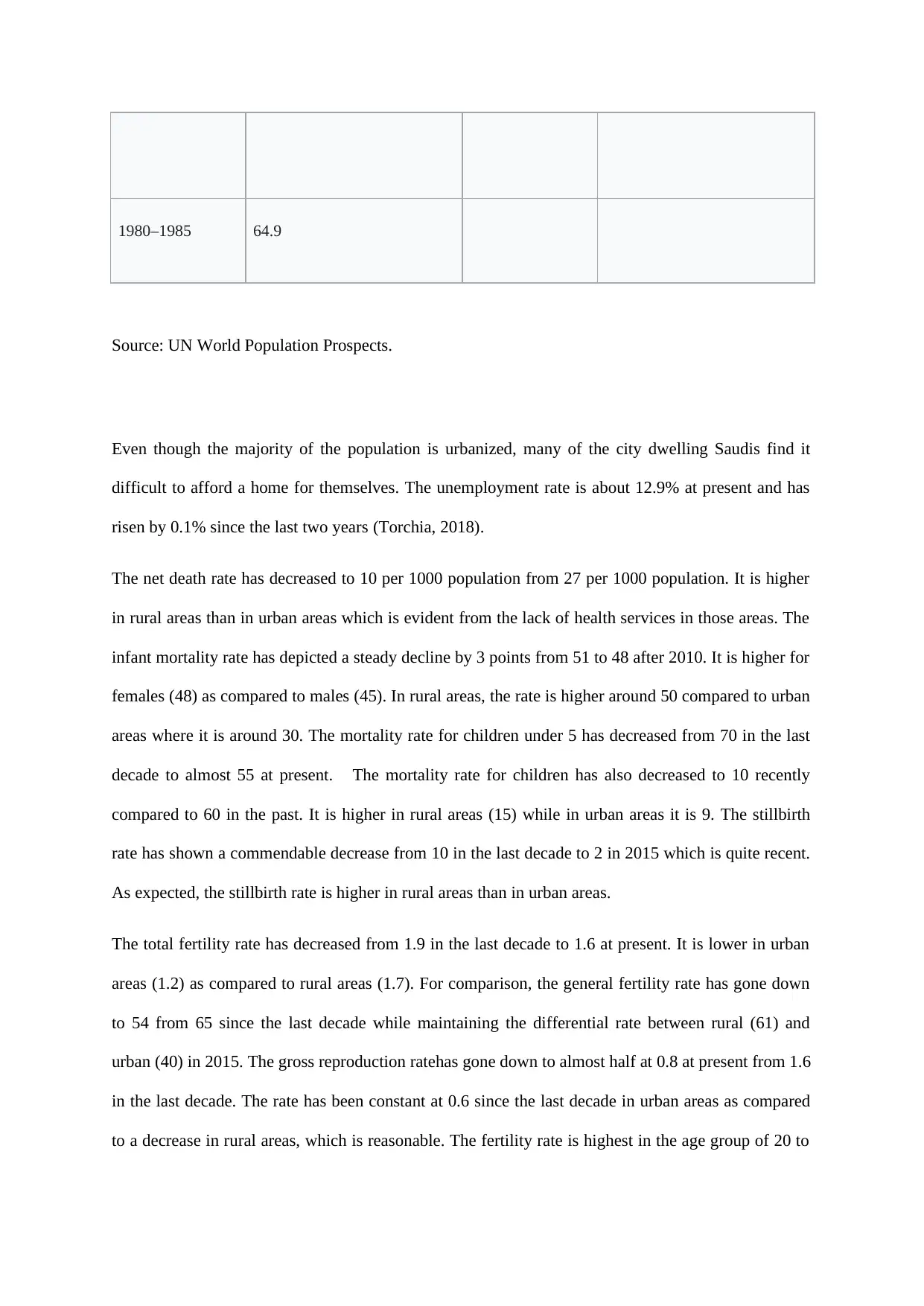
1980–1985 64.9
Source: UN World Population Prospects.
Even though the majority of the population is urbanized, many of the city dwelling Saudis find it
difficult to afford a home for themselves. The unemployment rate is about 12.9% at present and has
risen by 0.1% since the last two years (Torchia, 2018).
The net death rate has decreased to 10 per 1000 population from 27 per 1000 population. It is higher
in rural areas than in urban areas which is evident from the lack of health services in those areas. The
infant mortality rate has depicted a steady decline by 3 points from 51 to 48 after 2010. It is higher for
females (48) as compared to males (45). In rural areas, the rate is higher around 50 compared to urban
areas where it is around 30. The mortality rate for children under 5 has decreased from 70 in the last
decade to almost 55 at present. The mortality rate for children has also decreased to 10 recently
compared to 60 in the past. It is higher in rural areas (15) while in urban areas it is 9. The stillbirth
rate has shown a commendable decrease from 10 in the last decade to 2 in 2015 which is quite recent.
As expected, the stillbirth rate is higher in rural areas than in urban areas.
The total fertility rate has decreased from 1.9 in the last decade to 1.6 at present. It is lower in urban
areas (1.2) as compared to rural areas (1.7). For comparison, the general fertility rate has gone down
to 54 from 65 since the last decade while maintaining the differential rate between rural (61) and
urban (40) in 2015. The gross reproduction ratehas gone down to almost half at 0.8 at present from 1.6
in the last decade. The rate has been constant at 0.6 since the last decade in urban areas as compared
to a decrease in rural areas, which is reasonable. The fertility rate is highest in the age group of 20 to
Source: UN World Population Prospects.
Even though the majority of the population is urbanized, many of the city dwelling Saudis find it
difficult to afford a home for themselves. The unemployment rate is about 12.9% at present and has
risen by 0.1% since the last two years (Torchia, 2018).
The net death rate has decreased to 10 per 1000 population from 27 per 1000 population. It is higher
in rural areas than in urban areas which is evident from the lack of health services in those areas. The
infant mortality rate has depicted a steady decline by 3 points from 51 to 48 after 2010. It is higher for
females (48) as compared to males (45). In rural areas, the rate is higher around 50 compared to urban
areas where it is around 30. The mortality rate for children under 5 has decreased from 70 in the last
decade to almost 55 at present. The mortality rate for children has also decreased to 10 recently
compared to 60 in the past. It is higher in rural areas (15) while in urban areas it is 9. The stillbirth
rate has shown a commendable decrease from 10 in the last decade to 2 in 2015 which is quite recent.
As expected, the stillbirth rate is higher in rural areas than in urban areas.
The total fertility rate has decreased from 1.9 in the last decade to 1.6 at present. It is lower in urban
areas (1.2) as compared to rural areas (1.7). For comparison, the general fertility rate has gone down
to 54 from 65 since the last decade while maintaining the differential rate between rural (61) and
urban (40) in 2015. The gross reproduction ratehas gone down to almost half at 0.8 at present from 1.6
in the last decade. The rate has been constant at 0.6 since the last decade in urban areas as compared
to a decrease in rural areas, which is reasonable. The fertility rate is highest in the age group of 20 to
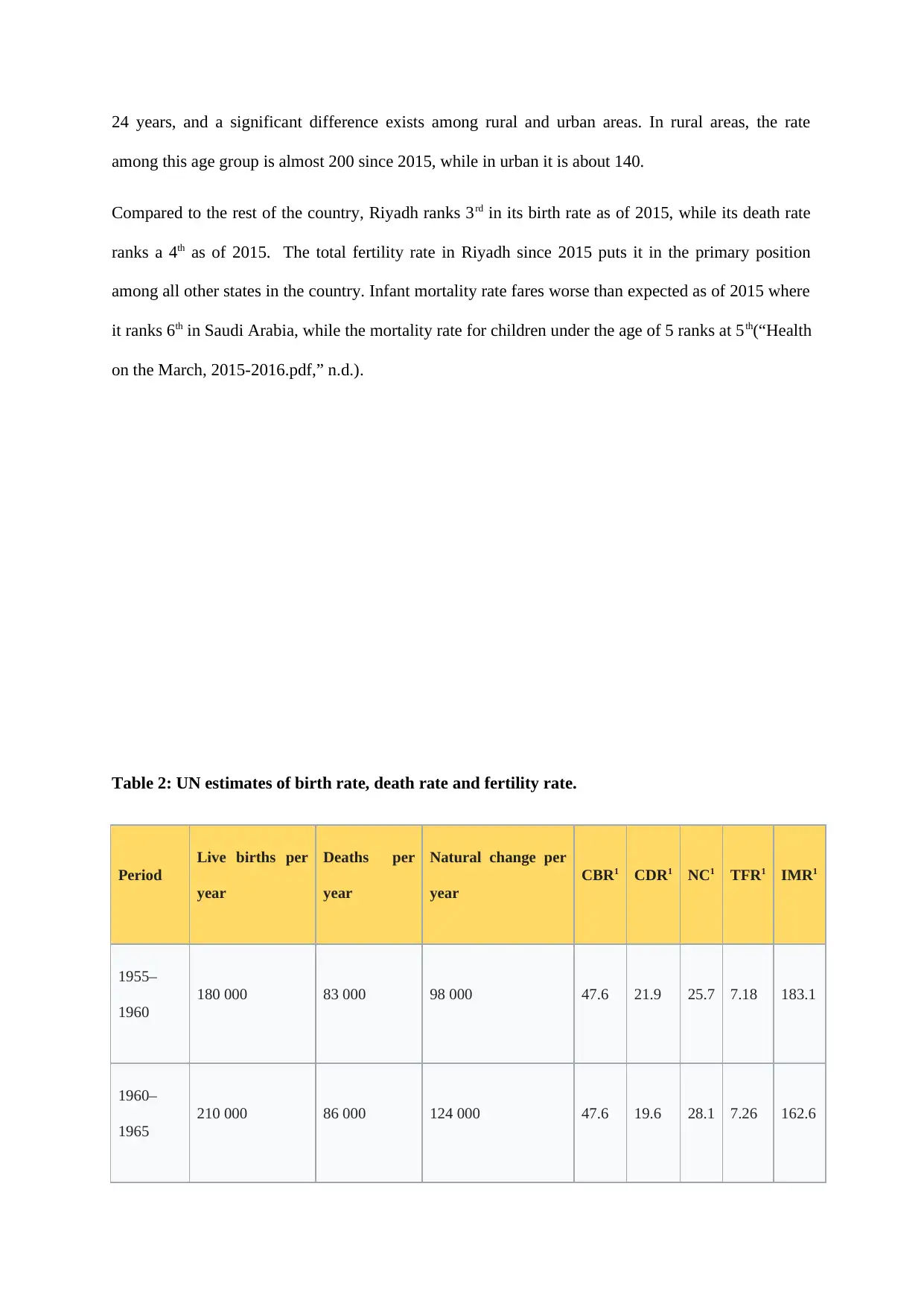
24 years, and a significant difference exists among rural and urban areas. In rural areas, the rate
among this age group is almost 200 since 2015, while in urban it is about 140.
Compared to the rest of the country, Riyadh ranks 3rd in its birth rate as of 2015, while its death rate
ranks a 4th as of 2015. The total fertility rate in Riyadh since 2015 puts it in the primary position
among all other states in the country. Infant mortality rate fares worse than expected as of 2015 where
it ranks 6th in Saudi Arabia, while the mortality rate for children under the age of 5 ranks at 5th(“Health
on the March, 2015-2016.pdf,” n.d.).
Table 2: UN estimates of birth rate, death rate and fertility rate.
Period
Live births per
year
Deaths per
year
Natural change per
year
CBR1 CDR1 NC1 TFR1 IMR1
1955–
1960
180 000 83 000 98 000 47.6 21.9 25.7 7.18 183.1
1960–
1965
210 000 86 000 124 000 47.6 19.6 28.1 7.26 162.6
among this age group is almost 200 since 2015, while in urban it is about 140.
Compared to the rest of the country, Riyadh ranks 3rd in its birth rate as of 2015, while its death rate
ranks a 4th as of 2015. The total fertility rate in Riyadh since 2015 puts it in the primary position
among all other states in the country. Infant mortality rate fares worse than expected as of 2015 where
it ranks 6th in Saudi Arabia, while the mortality rate for children under the age of 5 ranks at 5th(“Health
on the March, 2015-2016.pdf,” n.d.).
Table 2: UN estimates of birth rate, death rate and fertility rate.
Period
Live births per
year
Deaths per
year
Natural change per
year
CBR1 CDR1 NC1 TFR1 IMR1
1955–
1960
180 000 83 000 98 000 47.6 21.9 25.7 7.18 183.1
1960–
1965
210 000 86 000 124 000 47.6 19.6 28.1 7.26 162.6
⊘ This is a preview!⊘
Do you want full access?
Subscribe today to unlock all pages.

Trusted by 1+ million students worldwide
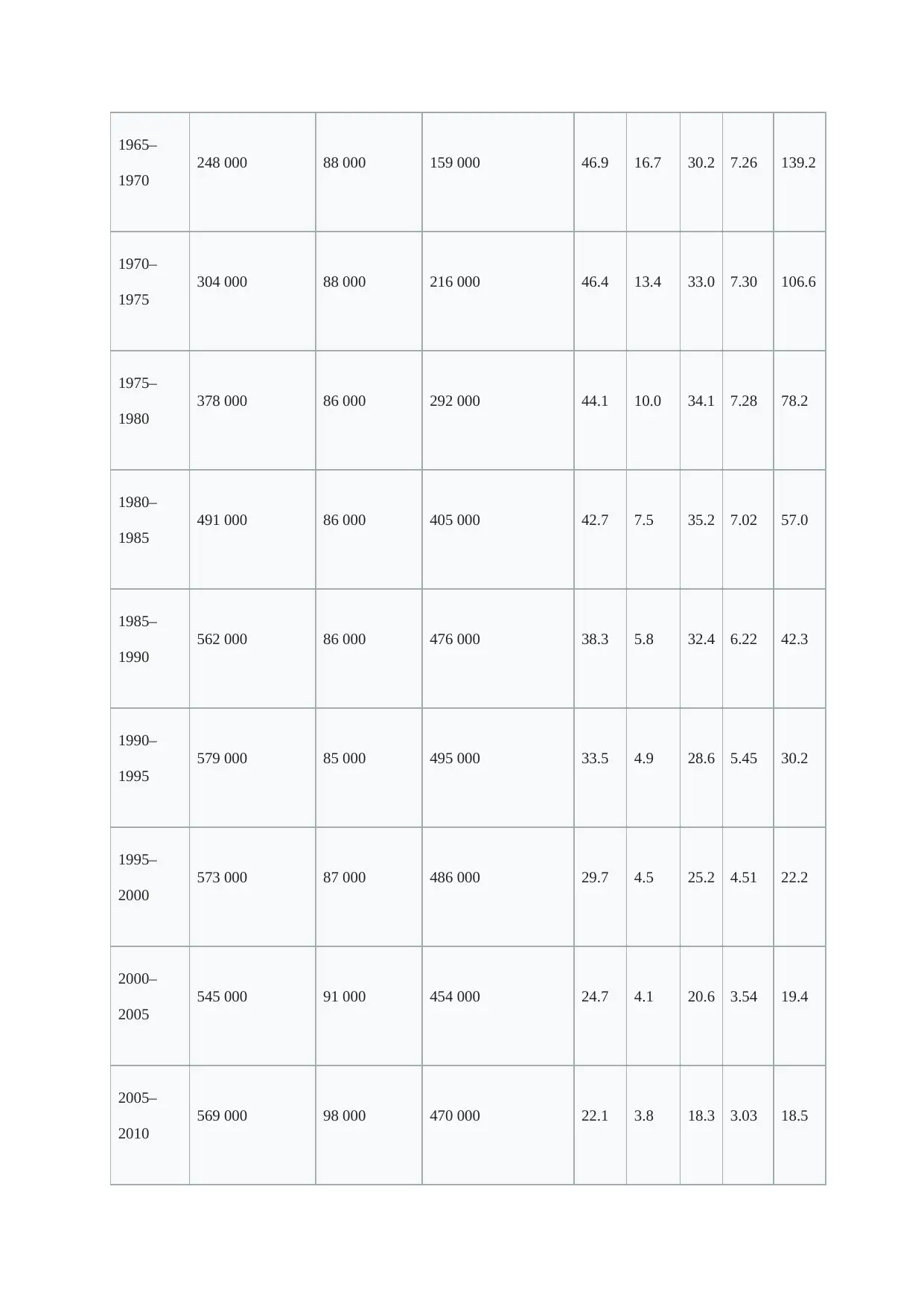
1965–
1970
248 000 88 000 159 000 46.9 16.7 30.2 7.26 139.2
1970–
1975
304 000 88 000 216 000 46.4 13.4 33.0 7.30 106.6
1975–
1980
378 000 86 000 292 000 44.1 10.0 34.1 7.28 78.2
1980–
1985
491 000 86 000 405 000 42.7 7.5 35.2 7.02 57.0
1985–
1990
562 000 86 000 476 000 38.3 5.8 32.4 6.22 42.3
1990–
1995
579 000 85 000 495 000 33.5 4.9 28.6 5.45 30.2
1995–
2000
573 000 87 000 486 000 29.7 4.5 25.2 4.51 22.2
2000–
2005
545 000 91 000 454 000 24.7 4.1 20.6 3.54 19.4
2005–
2010
569 000 98 000 470 000 22.1 3.8 18.3 3.03 18.5
1970
248 000 88 000 159 000 46.9 16.7 30.2 7.26 139.2
1970–
1975
304 000 88 000 216 000 46.4 13.4 33.0 7.30 106.6
1975–
1980
378 000 86 000 292 000 44.1 10.0 34.1 7.28 78.2
1980–
1985
491 000 86 000 405 000 42.7 7.5 35.2 7.02 57.0
1985–
1990
562 000 86 000 476 000 38.3 5.8 32.4 6.22 42.3
1990–
1995
579 000 85 000 495 000 33.5 4.9 28.6 5.45 30.2
1995–
2000
573 000 87 000 486 000 29.7 4.5 25.2 4.51 22.2
2000–
2005
545 000 91 000 454 000 24.7 4.1 20.6 3.54 19.4
2005–
2010
569 000 98 000 470 000 22.1 3.8 18.3 3.03 18.5
Paraphrase This Document
Need a fresh take? Get an instant paraphrase of this document with our AI Paraphraser
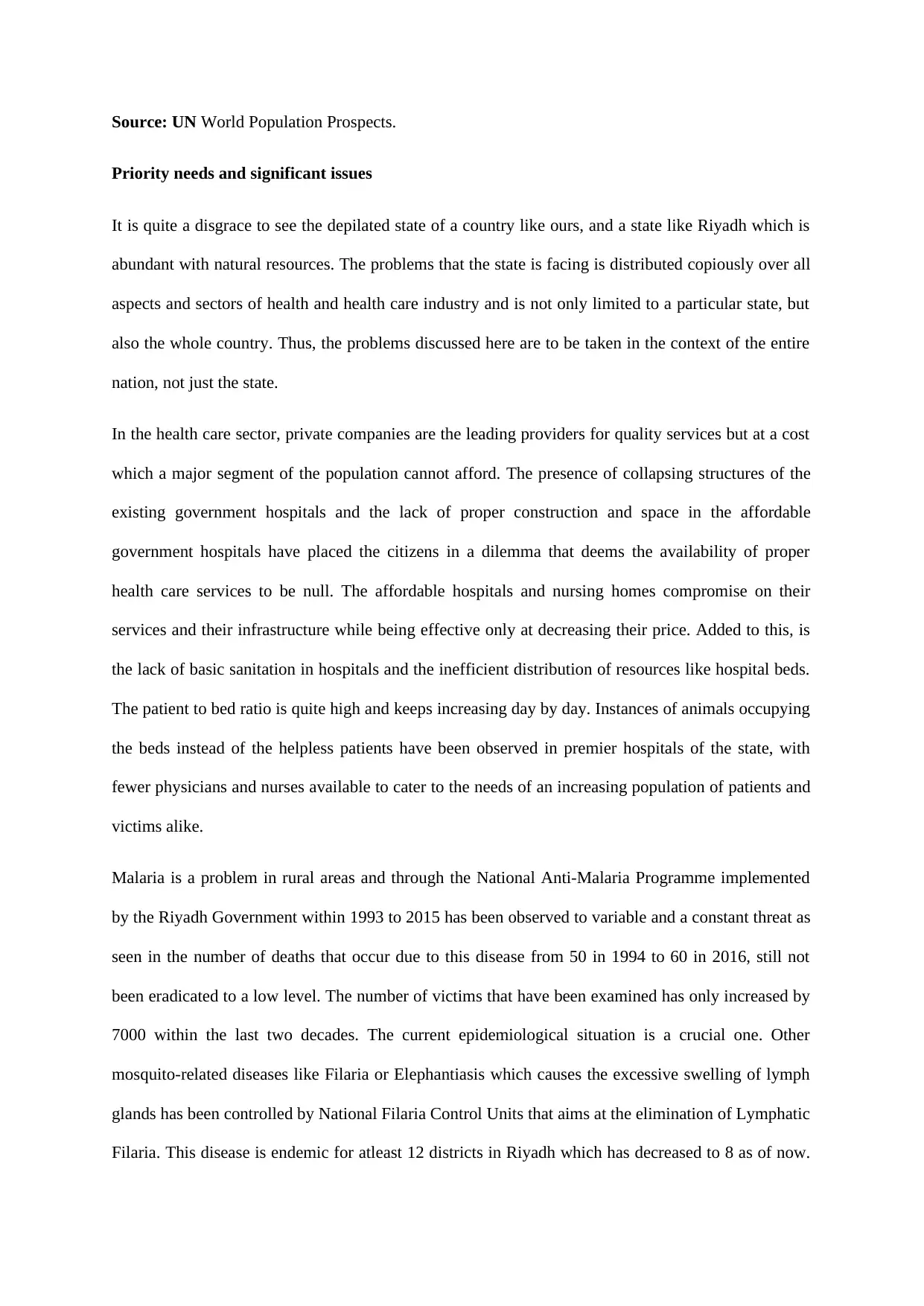
Source: UN World Population Prospects.
Priority needs and significant issues
It is quite a disgrace to see the depilated state of a country like ours, and a state like Riyadh which is
abundant with natural resources. The problems that the state is facing is distributed copiously over all
aspects and sectors of health and health care industry and is not only limited to a particular state, but
also the whole country. Thus, the problems discussed here are to be taken in the context of the entire
nation, not just the state.
In the health care sector, private companies are the leading providers for quality services but at a cost
which a major segment of the population cannot afford. The presence of collapsing structures of the
existing government hospitals and the lack of proper construction and space in the affordable
government hospitals have placed the citizens in a dilemma that deems the availability of proper
health care services to be null. The affordable hospitals and nursing homes compromise on their
services and their infrastructure while being effective only at decreasing their price. Added to this, is
the lack of basic sanitation in hospitals and the inefficient distribution of resources like hospital beds.
The patient to bed ratio is quite high and keeps increasing day by day. Instances of animals occupying
the beds instead of the helpless patients have been observed in premier hospitals of the state, with
fewer physicians and nurses available to cater to the needs of an increasing population of patients and
victims alike.
Malaria is a problem in rural areas and through the National Anti-Malaria Programme implemented
by the Riyadh Government within 1993 to 2015 has been observed to variable and a constant threat as
seen in the number of deaths that occur due to this disease from 50 in 1994 to 60 in 2016, still not
been eradicated to a low level. The number of victims that have been examined has only increased by
7000 within the last two decades. The current epidemiological situation is a crucial one. Other
mosquito-related diseases like Filaria or Elephantiasis which causes the excessive swelling of lymph
glands has been controlled by National Filaria Control Units that aims at the elimination of Lymphatic
Filaria. This disease is endemic for atleast 12 districts in Riyadh which has decreased to 8 as of now.
Priority needs and significant issues
It is quite a disgrace to see the depilated state of a country like ours, and a state like Riyadh which is
abundant with natural resources. The problems that the state is facing is distributed copiously over all
aspects and sectors of health and health care industry and is not only limited to a particular state, but
also the whole country. Thus, the problems discussed here are to be taken in the context of the entire
nation, not just the state.
In the health care sector, private companies are the leading providers for quality services but at a cost
which a major segment of the population cannot afford. The presence of collapsing structures of the
existing government hospitals and the lack of proper construction and space in the affordable
government hospitals have placed the citizens in a dilemma that deems the availability of proper
health care services to be null. The affordable hospitals and nursing homes compromise on their
services and their infrastructure while being effective only at decreasing their price. Added to this, is
the lack of basic sanitation in hospitals and the inefficient distribution of resources like hospital beds.
The patient to bed ratio is quite high and keeps increasing day by day. Instances of animals occupying
the beds instead of the helpless patients have been observed in premier hospitals of the state, with
fewer physicians and nurses available to cater to the needs of an increasing population of patients and
victims alike.
Malaria is a problem in rural areas and through the National Anti-Malaria Programme implemented
by the Riyadh Government within 1993 to 2015 has been observed to variable and a constant threat as
seen in the number of deaths that occur due to this disease from 50 in 1994 to 60 in 2016, still not
been eradicated to a low level. The number of victims that have been examined has only increased by
7000 within the last two decades. The current epidemiological situation is a crucial one. Other
mosquito-related diseases like Filaria or Elephantiasis which causes the excessive swelling of lymph
glands has been controlled by National Filaria Control Units that aims at the elimination of Lymphatic
Filaria. This disease is endemic for atleast 12 districts in Riyadh which has decreased to 8 as of now.
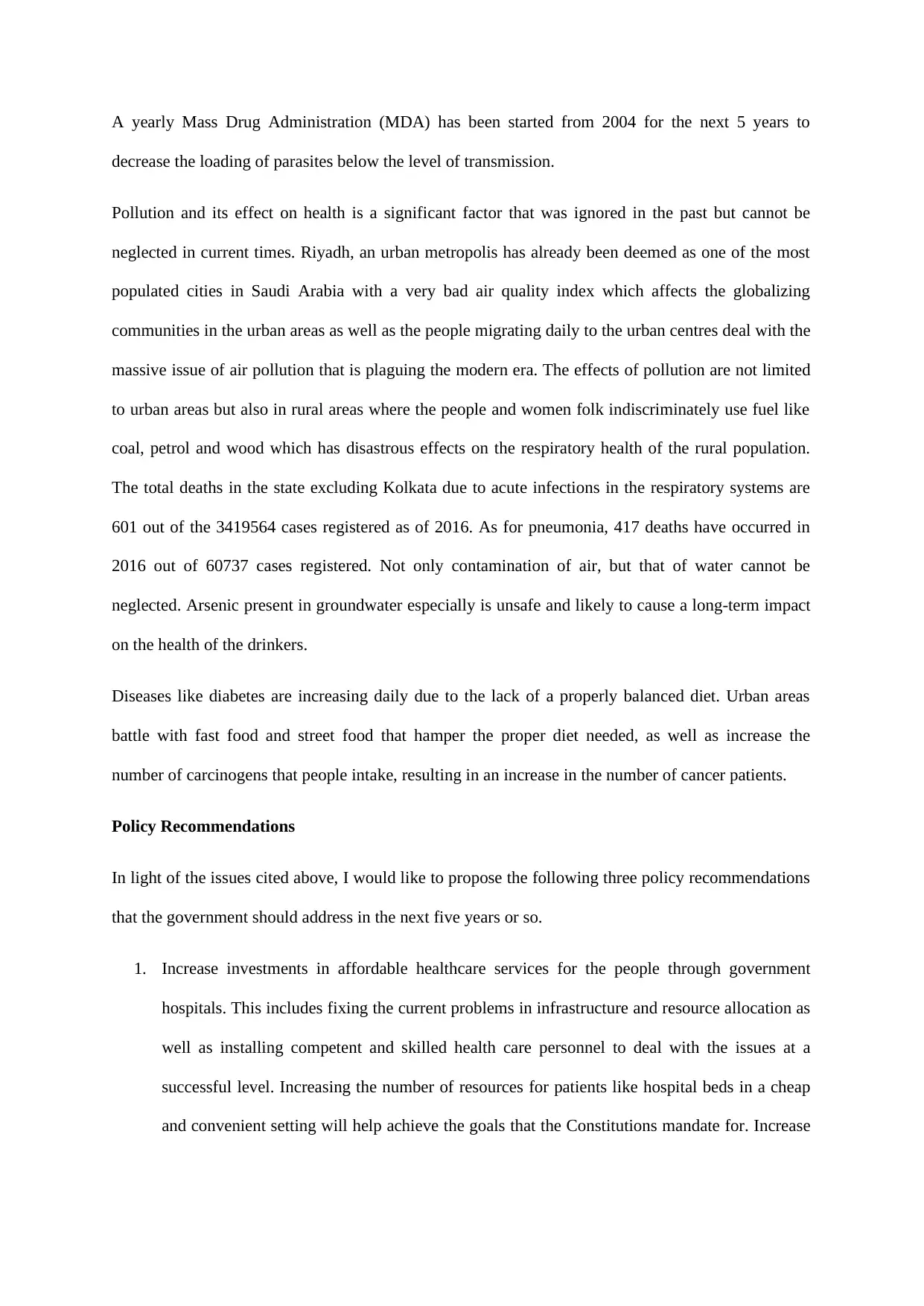
A yearly Mass Drug Administration (MDA) has been started from 2004 for the next 5 years to
decrease the loading of parasites below the level of transmission.
Pollution and its effect on health is a significant factor that was ignored in the past but cannot be
neglected in current times. Riyadh, an urban metropolis has already been deemed as one of the most
populated cities in Saudi Arabia with a very bad air quality index which affects the globalizing
communities in the urban areas as well as the people migrating daily to the urban centres deal with the
massive issue of air pollution that is plaguing the modern era. The effects of pollution are not limited
to urban areas but also in rural areas where the people and women folk indiscriminately use fuel like
coal, petrol and wood which has disastrous effects on the respiratory health of the rural population.
The total deaths in the state excluding Kolkata due to acute infections in the respiratory systems are
601 out of the 3419564 cases registered as of 2016. As for pneumonia, 417 deaths have occurred in
2016 out of 60737 cases registered. Not only contamination of air, but that of water cannot be
neglected. Arsenic present in groundwater especially is unsafe and likely to cause a long-term impact
on the health of the drinkers.
Diseases like diabetes are increasing daily due to the lack of a properly balanced diet. Urban areas
battle with fast food and street food that hamper the proper diet needed, as well as increase the
number of carcinogens that people intake, resulting in an increase in the number of cancer patients.
Policy Recommendations
In light of the issues cited above, I would like to propose the following three policy recommendations
that the government should address in the next five years or so.
1. Increase investments in affordable healthcare services for the people through government
hospitals. This includes fixing the current problems in infrastructure and resource allocation as
well as installing competent and skilled health care personnel to deal with the issues at a
successful level. Increasing the number of resources for patients like hospital beds in a cheap
and convenient setting will help achieve the goals that the Constitutions mandate for. Increase
decrease the loading of parasites below the level of transmission.
Pollution and its effect on health is a significant factor that was ignored in the past but cannot be
neglected in current times. Riyadh, an urban metropolis has already been deemed as one of the most
populated cities in Saudi Arabia with a very bad air quality index which affects the globalizing
communities in the urban areas as well as the people migrating daily to the urban centres deal with the
massive issue of air pollution that is plaguing the modern era. The effects of pollution are not limited
to urban areas but also in rural areas where the people and women folk indiscriminately use fuel like
coal, petrol and wood which has disastrous effects on the respiratory health of the rural population.
The total deaths in the state excluding Kolkata due to acute infections in the respiratory systems are
601 out of the 3419564 cases registered as of 2016. As for pneumonia, 417 deaths have occurred in
2016 out of 60737 cases registered. Not only contamination of air, but that of water cannot be
neglected. Arsenic present in groundwater especially is unsafe and likely to cause a long-term impact
on the health of the drinkers.
Diseases like diabetes are increasing daily due to the lack of a properly balanced diet. Urban areas
battle with fast food and street food that hamper the proper diet needed, as well as increase the
number of carcinogens that people intake, resulting in an increase in the number of cancer patients.
Policy Recommendations
In light of the issues cited above, I would like to propose the following three policy recommendations
that the government should address in the next five years or so.
1. Increase investments in affordable healthcare services for the people through government
hospitals. This includes fixing the current problems in infrastructure and resource allocation as
well as installing competent and skilled health care personnel to deal with the issues at a
successful level. Increasing the number of resources for patients like hospital beds in a cheap
and convenient setting will help achieve the goals that the Constitutions mandate for. Increase
⊘ This is a preview!⊘
Do you want full access?
Subscribe today to unlock all pages.

Trusted by 1+ million students worldwide
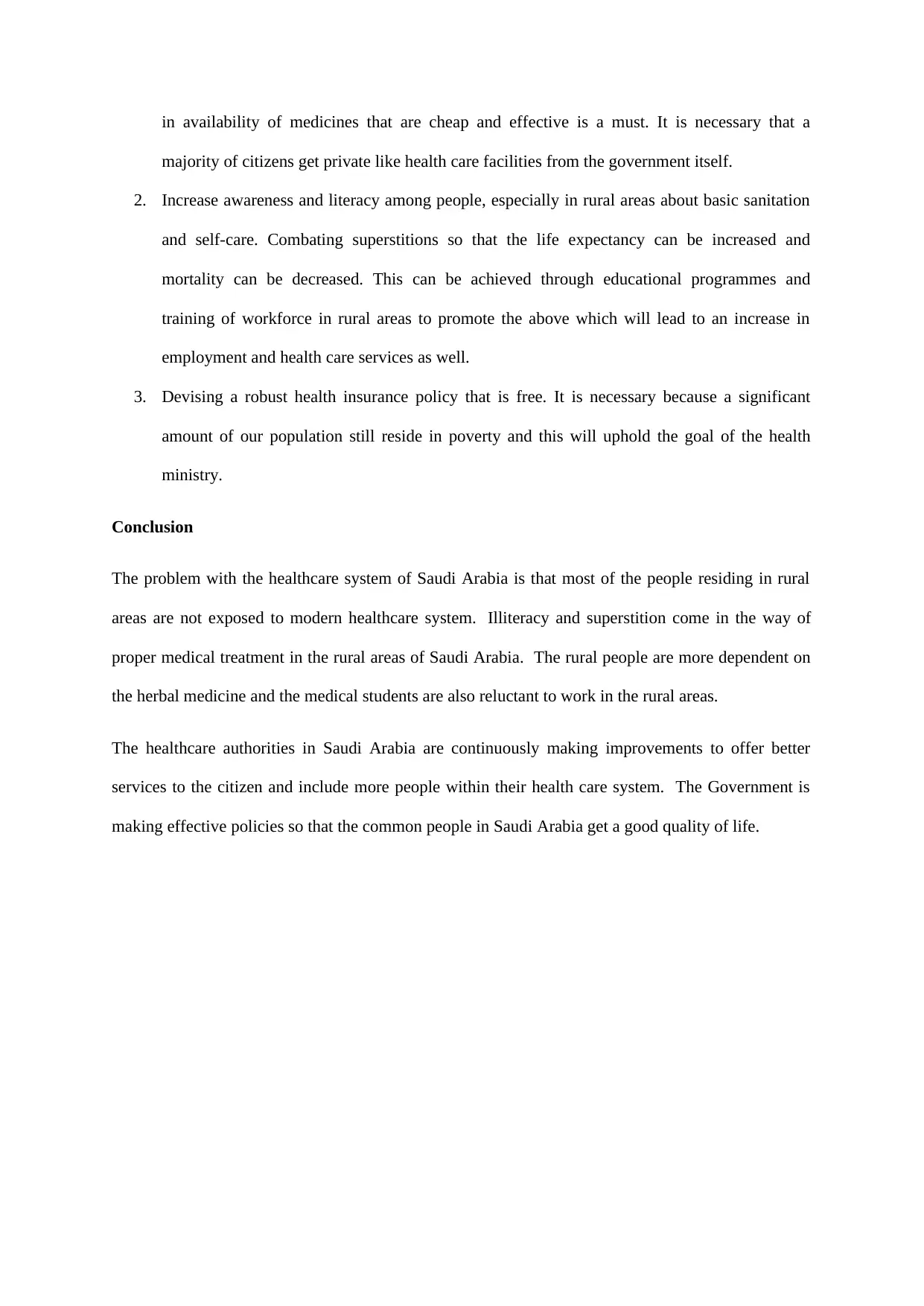
in availability of medicines that are cheap and effective is a must. It is necessary that a
majority of citizens get private like health care facilities from the government itself.
2. Increase awareness and literacy among people, especially in rural areas about basic sanitation
and self-care. Combating superstitions so that the life expectancy can be increased and
mortality can be decreased. This can be achieved through educational programmes and
training of workforce in rural areas to promote the above which will lead to an increase in
employment and health care services as well.
3. Devising a robust health insurance policy that is free. It is necessary because a significant
amount of our population still reside in poverty and this will uphold the goal of the health
ministry.
Conclusion
The problem with the healthcare system of Saudi Arabia is that most of the people residing in rural
areas are not exposed to modern healthcare system. Illiteracy and superstition come in the way of
proper medical treatment in the rural areas of Saudi Arabia. The rural people are more dependent on
the herbal medicine and the medical students are also reluctant to work in the rural areas.
The healthcare authorities in Saudi Arabia are continuously making improvements to offer better
services to the citizen and include more people within their health care system. The Government is
making effective policies so that the common people in Saudi Arabia get a good quality of life.
majority of citizens get private like health care facilities from the government itself.
2. Increase awareness and literacy among people, especially in rural areas about basic sanitation
and self-care. Combating superstitions so that the life expectancy can be increased and
mortality can be decreased. This can be achieved through educational programmes and
training of workforce in rural areas to promote the above which will lead to an increase in
employment and health care services as well.
3. Devising a robust health insurance policy that is free. It is necessary because a significant
amount of our population still reside in poverty and this will uphold the goal of the health
ministry.
Conclusion
The problem with the healthcare system of Saudi Arabia is that most of the people residing in rural
areas are not exposed to modern healthcare system. Illiteracy and superstition come in the way of
proper medical treatment in the rural areas of Saudi Arabia. The rural people are more dependent on
the herbal medicine and the medical students are also reluctant to work in the rural areas.
The healthcare authorities in Saudi Arabia are continuously making improvements to offer better
services to the citizen and include more people within their health care system. The Government is
making effective policies so that the common people in Saudi Arabia get a good quality of life.
Paraphrase This Document
Need a fresh take? Get an instant paraphrase of this document with our AI Paraphraser
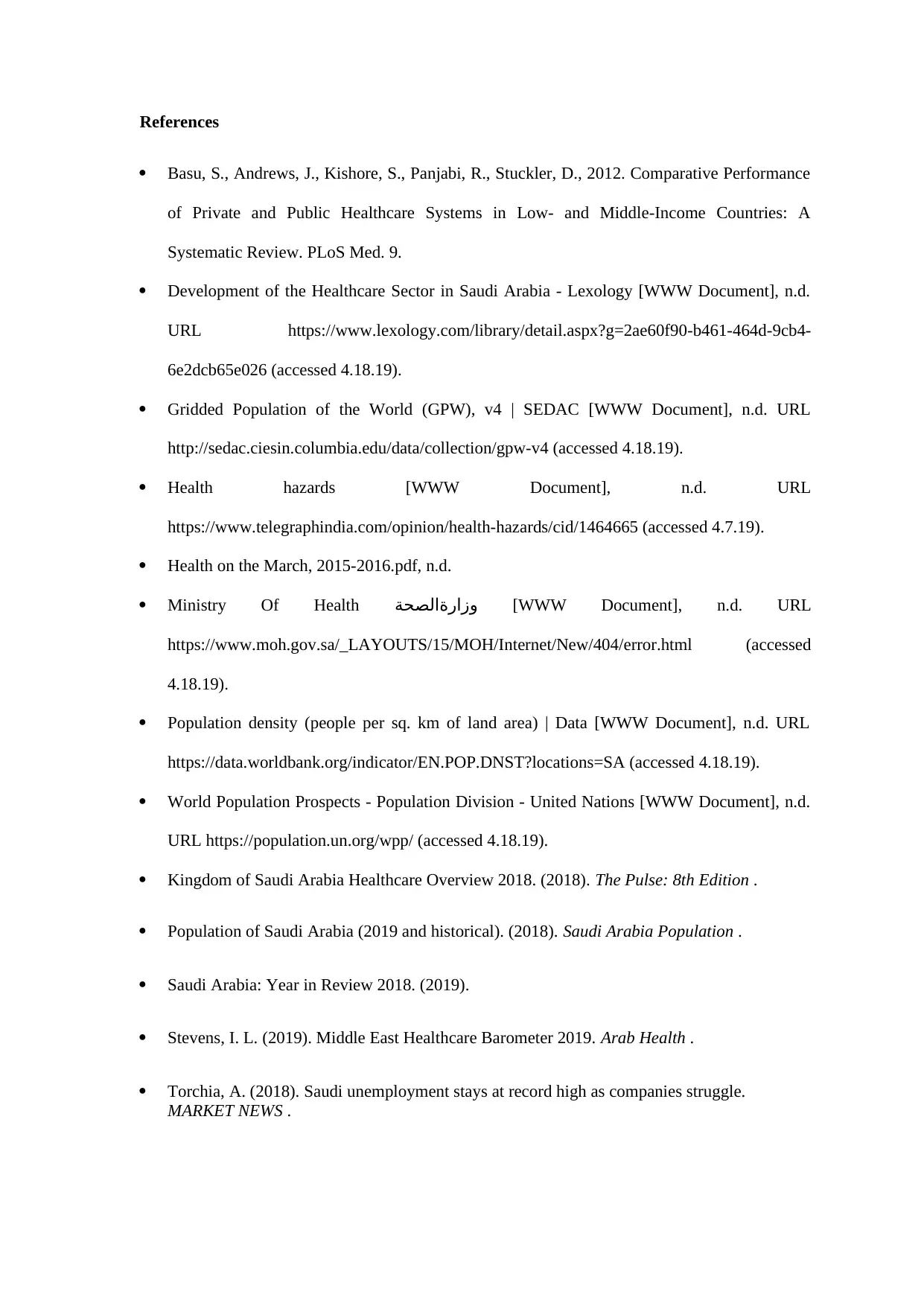
References
Basu, S., Andrews, J., Kishore, S., Panjabi, R., Stuckler, D., 2012. Comparative Performance
of Private and Public Healthcare Systems in Low- and Middle-Income Countries: A
Systematic Review. PLoS Med. 9.
Development of the Healthcare Sector in Saudi Arabia - Lexology [WWW Document], n.d.
URL https://www.lexology.com/library/detail.aspx?g=2ae60f90-b461-464d-9cb4-
6e2dcb65e026 (accessed 4.18.19).
Gridded Population of the World (GPW), v4 | SEDAC [WWW Document], n.d. URL
http://sedac.ciesin.columbia.edu/data/collection/gpw-v4 (accessed 4.18.19).
Health hazards [WWW Document], n.d. URL
https://www.telegraphindia.com/opinion/health-hazards/cid/1464665 (accessed 4.7.19).
Health on the March, 2015-2016.pdf, n.d.
Ministry Of Health وزارةالصحة [WWW Document], n.d. URL
https://www.moh.gov.sa/_LAYOUTS/15/MOH/Internet/New/404/error.html (accessed
4.18.19).
Population density (people per sq. km of land area) | Data [WWW Document], n.d. URL
https://data.worldbank.org/indicator/EN.POP.DNST?locations=SA (accessed 4.18.19).
World Population Prospects - Population Division - United Nations [WWW Document], n.d.
URL https://population.un.org/wpp/ (accessed 4.18.19).
Kingdom of Saudi Arabia Healthcare Overview 2018. (2018). The Pulse: 8th Edition .
Population of Saudi Arabia (2019 and historical). (2018). Saudi Arabia Population .
Saudi Arabia: Year in Review 2018. (2019).
Stevens, I. L. (2019). Middle East Healthcare Barometer 2019. Arab Health .
Torchia, A. (2018). Saudi unemployment stays at record high as companies struggle.
MARKET NEWS .
Basu, S., Andrews, J., Kishore, S., Panjabi, R., Stuckler, D., 2012. Comparative Performance
of Private and Public Healthcare Systems in Low- and Middle-Income Countries: A
Systematic Review. PLoS Med. 9.
Development of the Healthcare Sector in Saudi Arabia - Lexology [WWW Document], n.d.
URL https://www.lexology.com/library/detail.aspx?g=2ae60f90-b461-464d-9cb4-
6e2dcb65e026 (accessed 4.18.19).
Gridded Population of the World (GPW), v4 | SEDAC [WWW Document], n.d. URL
http://sedac.ciesin.columbia.edu/data/collection/gpw-v4 (accessed 4.18.19).
Health hazards [WWW Document], n.d. URL
https://www.telegraphindia.com/opinion/health-hazards/cid/1464665 (accessed 4.7.19).
Health on the March, 2015-2016.pdf, n.d.
Ministry Of Health وزارةالصحة [WWW Document], n.d. URL
https://www.moh.gov.sa/_LAYOUTS/15/MOH/Internet/New/404/error.html (accessed
4.18.19).
Population density (people per sq. km of land area) | Data [WWW Document], n.d. URL
https://data.worldbank.org/indicator/EN.POP.DNST?locations=SA (accessed 4.18.19).
World Population Prospects - Population Division - United Nations [WWW Document], n.d.
URL https://population.un.org/wpp/ (accessed 4.18.19).
Kingdom of Saudi Arabia Healthcare Overview 2018. (2018). The Pulse: 8th Edition .
Population of Saudi Arabia (2019 and historical). (2018). Saudi Arabia Population .
Saudi Arabia: Year in Review 2018. (2019).
Stevens, I. L. (2019). Middle East Healthcare Barometer 2019. Arab Health .
Torchia, A. (2018). Saudi unemployment stays at record high as companies struggle.
MARKET NEWS .

⊘ This is a preview!⊘
Do you want full access?
Subscribe today to unlock all pages.

Trusted by 1+ million students worldwide
1 out of 13
Related Documents
Your All-in-One AI-Powered Toolkit for Academic Success.
+13062052269
info@desklib.com
Available 24*7 on WhatsApp / Email
![[object Object]](/_next/static/media/star-bottom.7253800d.svg)
Unlock your academic potential
Copyright © 2020–2025 A2Z Services. All Rights Reserved. Developed and managed by ZUCOL.





